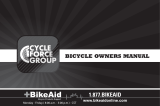
32
ASSEMBLY
Cantilever Brakes – Straddle Cable
The length of the straddle cable, the height of the straddle hanger and
the brake pad-to-caliper arm position all have an effect on braking
power. Generally, the straddle cable should be high enough, however,
to adequately clear the tire (and any debris that may stick to the tire) or
to fit over the front reflector hanger. The straddle cable length (when
adjustable) is set to transfer as much force to the brake pads as possible.
For the most efficient transfer of force, the straddle cable and the line
between the cantilever pivot and the cable anchor should form a right
angle (90 degrees). If the force is not at a right angle, part of the force
gets wasted in pulling on the brake post, which has no effect on braking.
V-Style Brakes
Take the brake noodle from the parts box and slide the cable through
the larger opening. The cable housing will then seat into the end of the
noodle. Slide the cable through the cable lead on the end of the left brake
arm, this will cause the noodle to fit into the lead. Slip the brake cable
boot over the cable and position it between both brake arms. Next, loosen
the 5mm anchor bolt at the end of the right brake arm and slide the cable
under the retaining washer. Pull the slack out of the cable making sure
a distance of 39mm or more remains between the end of the lead and
the start of the anchor bolt. Once the cable is secured to the brake arms,
engage the brake lever several times, checking the position of the brake
shoes at the rim. The brake shoes should be 1mm away from the rim
when in a relaxed position. When the brake lever is engaged, the brake
shoe should hit the rim flush (never the tire) with the front touching slightly
before the rear. If this position is not achieved, adjustments to the brake
shoe are required. Loosen the brake shoe hardware and reposition the
brake shoe. It may take several shoe and cable adjustments before the
required position is accomplished.
Straddle
Cable
Brake
Brake Cable
Straddle Hanger
Straddle Cable
Cable
Anchor
Caliper Arm
Pinch Bolt
Pivot
90
o
Brake
Noodle
Outer
Cable
Lead
Brake
Cable
Boot
Anchor
Bolt
Brake
Arm
Tension
Screw
Brake
Shoe
Pivot
Bolt




























